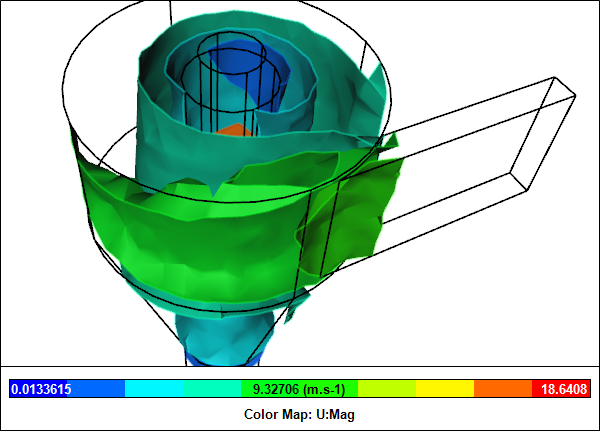
Fluid Device Design is Like Herding Cats So Let CFD Help
Where the action of a fluid is the primary concern in the design of a device, e.g., a cyclone, sometimes it can seem that fluid is going out of its way to be difficult - a lot like trying to herd cats. Fluid device designers have to carefully match geometry to flow rates to meet performance criteria. However, if they were to rely solely on physical testing, then their task is that much harder and more costly because they can't easily visualize the flow behavior. Let Computational Fluid Dynamics (CFD) save you money and time as a supplement to physical testing.
 CFD Simulation of a CycloneVelocity iso-surfaces within the flow volume
CFD Simulation of a CycloneVelocity iso-surfaces within the flow volume
CFD can not only extract performance criteria (e.g., pressure drop), but you can also visualize the entire flow field to see where recirculations might be forming and compromising the efficiency of the design. Then within virtual prototype space you can easily make geometry changes to narrow down your initial design to the most promising. In this manner CFD is a great tool for running virtual experiments to quickly evaluate many configurations as a relatively inexpensive and timely alternative to constructing equivalent physical tests. Physical testing still plays an important role, but it can then be limited to those configurations that have shown the most promise during their virtual prototype testing.
CFD Simulation of a CycloneParticle animation
In combination, virtual and physical testing can be used to validate performance against each other and thus together promote a more efficient overall strategy than using one to the exclusion of the other.
Recent blog posts
- CFD Simulates Distant Past
- Background on the Caedium v6.0 Release
- Long-Necked Dinosaurs Succumb To CFD
- CFD Provides Insight Into Mystery Fossils
- Wind Turbine Design According to Insects
- Runners Discover Drafting
- Wind Tunnel and CFD Reveal Best Cycling Tuck
- Active Aerodynamics on the Lamborghini Huracán Performante
- Fluidic Logic
- Stonehenge Vortex Revealed as April Fools' Day Distortion Field
